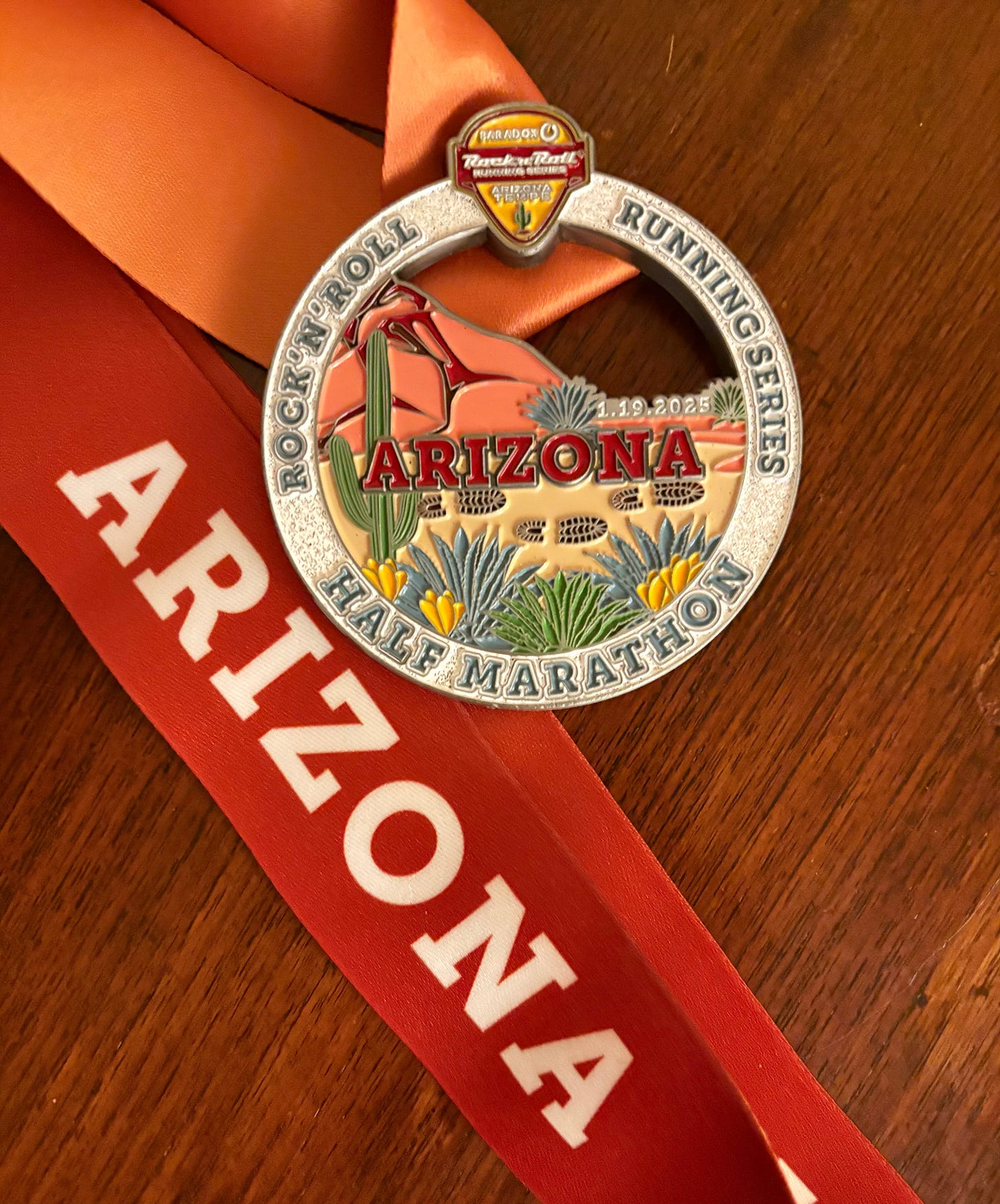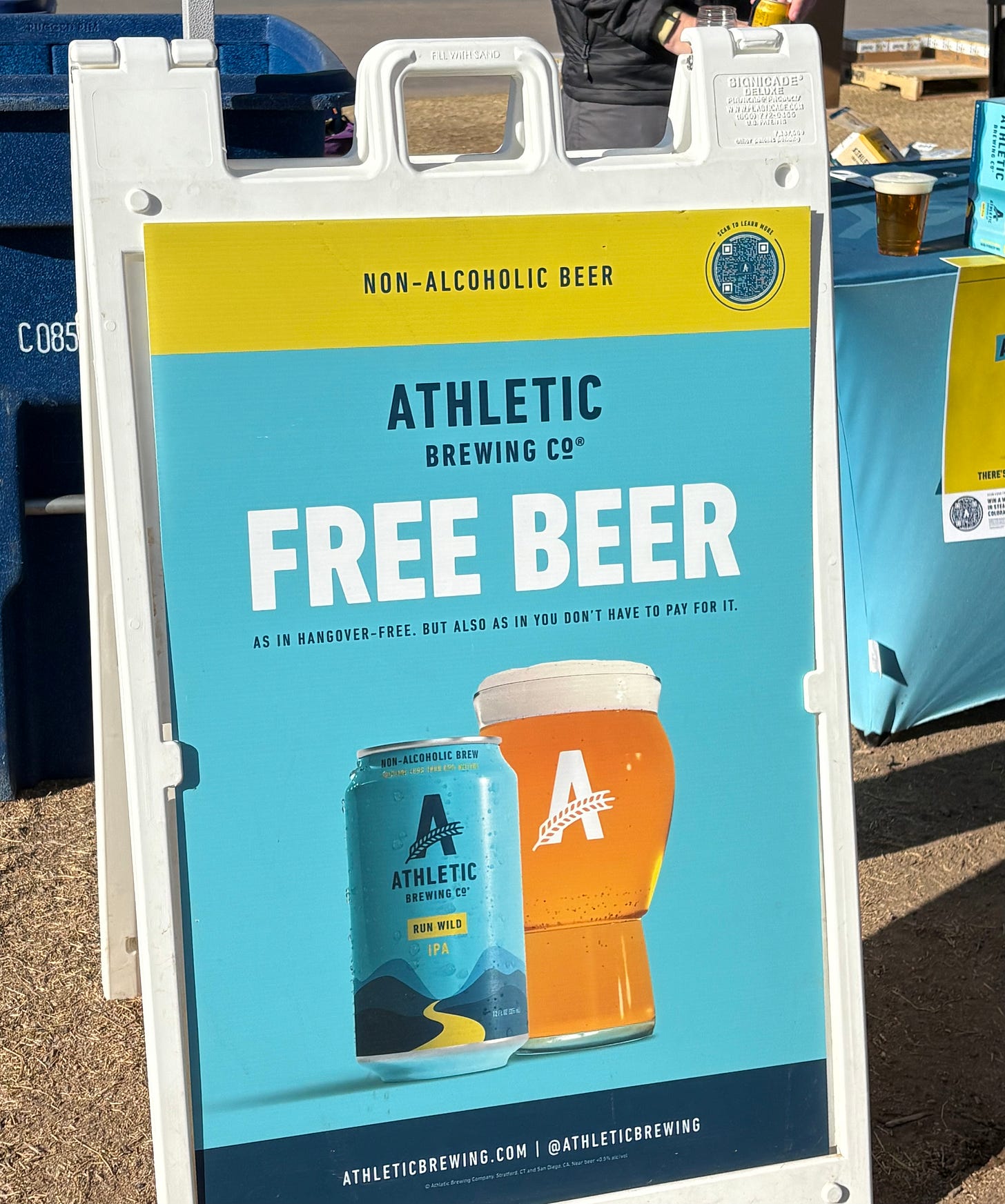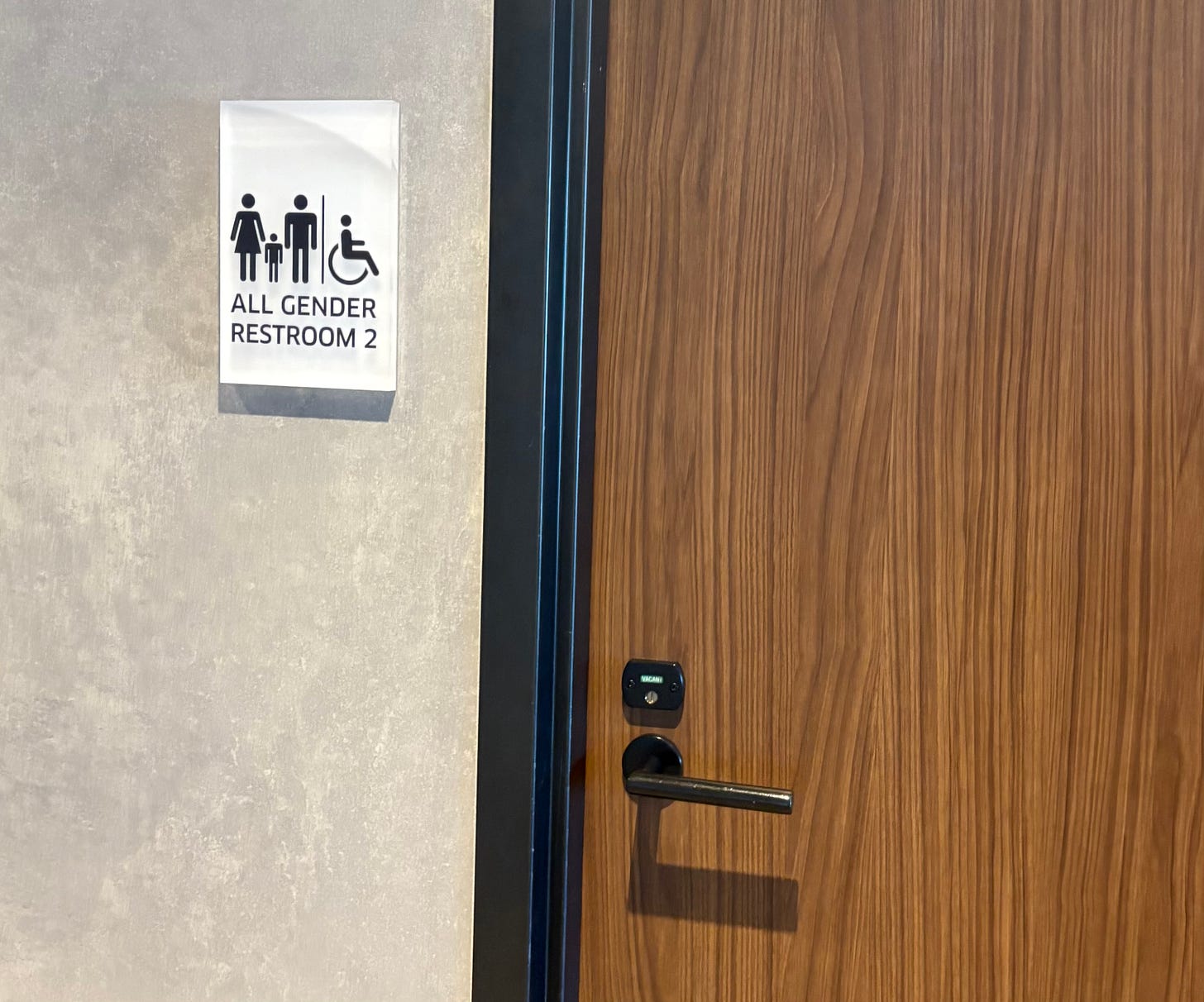Phoenix Rock ’n’ Roll Half Marathon: 2025 race review
Plus: What has happened to Rock ’n’ Roll? Non-alcoholic beer that tastes better than the real thing? Credit card airport lounges vs. airline ones. And how come so few bathrooms in some lounges?
I ran the Phoenix Rock ’n’ Roll Half Marathon in January. Here’s my report, as well as some travel notes and thoughts.

Running into the New Year
January is low season for distance races, pretty much all over the world. After a flurry of big November races, such as the New York Marathon, the race calendar shuts down for midwinter in many parts of the northern hemisphere. And in the southern half of the planet, mid-summer temperatures make the first month of the year less than ideal. Australian races, for example, tend to take place between May and September.
However, there are exceptions. There are no big January races in Europe. But in Asia, there’s Hong Kong. And in the U.S., some of the warmer states that draw snow birds escaping the cold are also winter magnets for runners. The biggest January event in the U.S. is now clearly the full and half marathon in Miami late in the month. The Phoenix Rock ’n’ Roll event used to be a contender for the top spot, but — while still a solid choice for runners looking for a winter half — is no longer quite what it was.
It has shrunk from being a full and half marathon with expansive courses and a bustling expo to a somewhat less ambitious half-only event (or, more precisely, half plus 5K and 10K). It isn’t just that the full marathon is gone, but numbers who take part in the half are also well down. In 2025, there were around 5,500 finishers. That compares with close to 7,000 in the half alone in 2020 and over 10,000 in 2017.
So, today, the Phoenix Rock ’n’ Roll is no more than a medium-size event. But that won’t bother a lot of people. The intermediate size can provide the energy of a large race, with less of the crowd. And some half runners prefer there not being a full marathon with which to share the limelight.
What’s up with Rock ’n’ Roll?
The scaling back of the Phoenix event reflects what has happened to the overall Rock ’n’ Roll series of which it is part. The series started in 1998 with a San Diego race, which remains its flagship today. I’ve run the San Diego Rock ’n’ Roll half seven times — all between 2012 and 2019 — and always enjoyed it.
The series expanded to include well over 20 events every year, mostly in the U.S. but also overseas. In its heyday, it had a loyal following of runners who would buy its Tour Passes, allowing multiple and even unlimited race entries throughout the year for a flat rate. Somewhere along the line, however, the expansion trend reversed. Races started to be discontinued. And new ones that were announced never actually took place. The pandemic then took its toll, but the contraction was evident before.
The change in Rock ’n’ Roll’s fortunes may have had to do with changes in ownership over the years. The original business was acquired in 2008 by Competitor Group, which ran various other endurance sporting events. It, in turn, was acquired by Ironman Group — another endurance conglomerate — in 2018. Before the Ironman acquisition, there had been a bit of a cloud over the series, following publicity about a blurring of the line between the for-profit and charitable parts of the operation. That, as well as a feeling among some runners that the races were coming a little too corporate, may have taken some of the shine off the brand.
As well as Phoenix, the other Rock ’n’ Roll races that still exist in 2025 are Las Vegas, Nashville, San Diego, San Jose, and Washington DC. Of those, only two — San Diego and Nashville — offer the full marathon distance as well as a half. There is also a Madrid event, one in Manila, and a planned new one in Taipei, the details of which were somewhat vague at the time of writing.
The fact that the Rock ’n’ Roll series isn’t quite what it once was is not a reason to avoid its events. Far from it, my experience of Phoenix in 2025 suggests they still know how to put on a decent race.
Volunteering with for-profit events
The charitable/for-profit thing is something I’ve wondered about with a number of races. Having private companies organize races makes sense if it leads to events that might not otherwise exist. But while there is nothing, per se, wrong with for-profit races, all races need volunteers. And large races need a lot of volunteers.
Not everyone wants to volunteer to line someone’s pockets. But the lines can blur when a primarily for-profit race donates a portion of proceeds to charities so as to have a philanthropic veneer. Volunteers might sometimes wonder who mostly benefits from their efforts. I guess runners certainly do, which is why it’s nice to thank the volunteers when you get a chance.
Coming back to Phoenix
I’ve now run the Phoenix Rock ’n’ Roll Half three times, including the 2025 event. The previous time was in January 2020, weeks before the pandemic forced a global shut-down of races. That led to a gap of almost 18 months before I took part in another (if you don’t count a “virtual Boston Half” I did on my own).
Whereas the 2020 Phoenix event preceded one hiatus, the 2025 one marked the end of another — for me, that is. Because this was my first half marathon after a heart issue — detailed elsewhere on this blog — left me incapable of running 13.1 miles for over a year, at first due to what what was for months an unexplained loss of strength and then during the recovery following a procedure once the problem was diagnosed.
A better course than before
The Rock ’n’ Roll Half Marathon has always started and ended in Tempe, a city within the overall Phoenix metropolis fairly close to the airport and east of downtown. Tempe is a college town. And with a bit of a party flavor. It’s home to Arizona State University, a large institution with almost 80,000 enrolled students.
Whereas the course used to start quite close to the campus and then carved out a large loop ending up a mile or so away in a park at the edge of Tempe Lake, it is now more of an out and back starting on Tempe’s main drag close to the lake and finishing nearby where it did before. I say “more” of an out and back, because the second half of the new course does not track the outbound path the whole way. Much of it does, but you also run on new surfaces while headed back in the general direction from which you’d come — including through some desert parkland toward the end.
The promo for the Phoenix Rock ’n’ Roll race has always tended to emphasize photographs of iconic Arizona nature, i.e., cacti and those reddish, rocky hills where the desert meets the city. But with the old loop course, you had to run a long way — around nine miles as I recall — before you saw any of that. Instead, you spent a lot of time running past dull strip malls, car dealerships, and office parks. On the whole, I’d say the new course is better even if it is less ambitious in terms of ground covered. While it still has its share of dull urban landscape, you have eye contact with Arizona-defining landscape for more of the course than before — including in the first few miles, although, as before, the landscape tends to peak toward the end.
Registration, packet pickup, and logistics
While the Rock ’n’ Roll series has had its detractors, one thing in its favor used to be relatively low pricing. That is not always the case now. I registered for the race fairly late, admittedly, but the asking price then was $178. That’s fairly steep, even allowing for inflation.
The good news is that it’s not hard to avoid paying full price. It can be a lot cheaper if you register way ahead. But you may not want to do that just in order to secure a place, as Rock ’n’ Roll races rarely sell out. Typically, they’re still selling places at the expo.
So the best way to keep the cost down without committing way ahead is to look for specials. I was able to snag $50 off with a New Year sale with less than three weeks to go until race day. You can also buy a Tour Pass giving you access to any three races in the series for $316 — 2025 pricing — but all three have to be in the same calendar year, so plan accordingly. And with the much diminished set of choices, the Tour Pass does not offer the utility it once did.
The price always includes a shirt, which tends to be quite nice — both in terms of material and design. I’ve put the one from Phoenix into my current rotation, as opposed to sending it straight to the give-away pile as occurs with some races. Gone, however, are the days when Rock ’n’ Roll runners got a Brooks shirt. That said, few races in the U.S. do offer name-brand shirts these days — at least not included in the registration price.
Like most largish races, Rock ’n’ Roll has always required runners to pick up their bibs and shirts at the expo. Their expos used to be quite large and bustling affairs with big-name vendors such as Garmin displaying their latest and greatest and the likes of Cliff Bars handing out free samples. But support among vendors for these types of expos has diminished. And the Phoenix one was not particularly uplifting or well-supported. Nor was it entirely clear why some of vendors were there — the Phoenix Sperm Bank, for example. Maybe runners give choice sperm.
That said, packet pickup-up was efficient. In fact, all aspects of this race were pretty efficient.
What’s annoying, however, is that Rock ’n’ Roll still insists on having the expo in the Convention Center in downtown Phoenix, roughly 10 miles from where the race starts and finishes. That location is overkill for the low-key reality of the occasion. It would be more convenient with a venue in Tempe, as that’s where visiting runners are likely to be staying.
Race day
The race began at 7:15 a.m. The early start makes sense. While the Phoenix weather in 2025 was pretty perfect for running, there is always the possibility of hotter temperatures at that time of year as the morning progresses. The race started right on time — in keeping with the overall efficiency of the event. A 10K went out with the half marathon (there’s also a 5K but that took place the day before).
Runners were assigned to different corrals, which — as is the case with most races — were not policed. My wave of middle-of-the-pack runners crossed the starting mats around 12 minutes after gun time. The first few minutes on the course were a bit crowded, but spacing opened up after that.
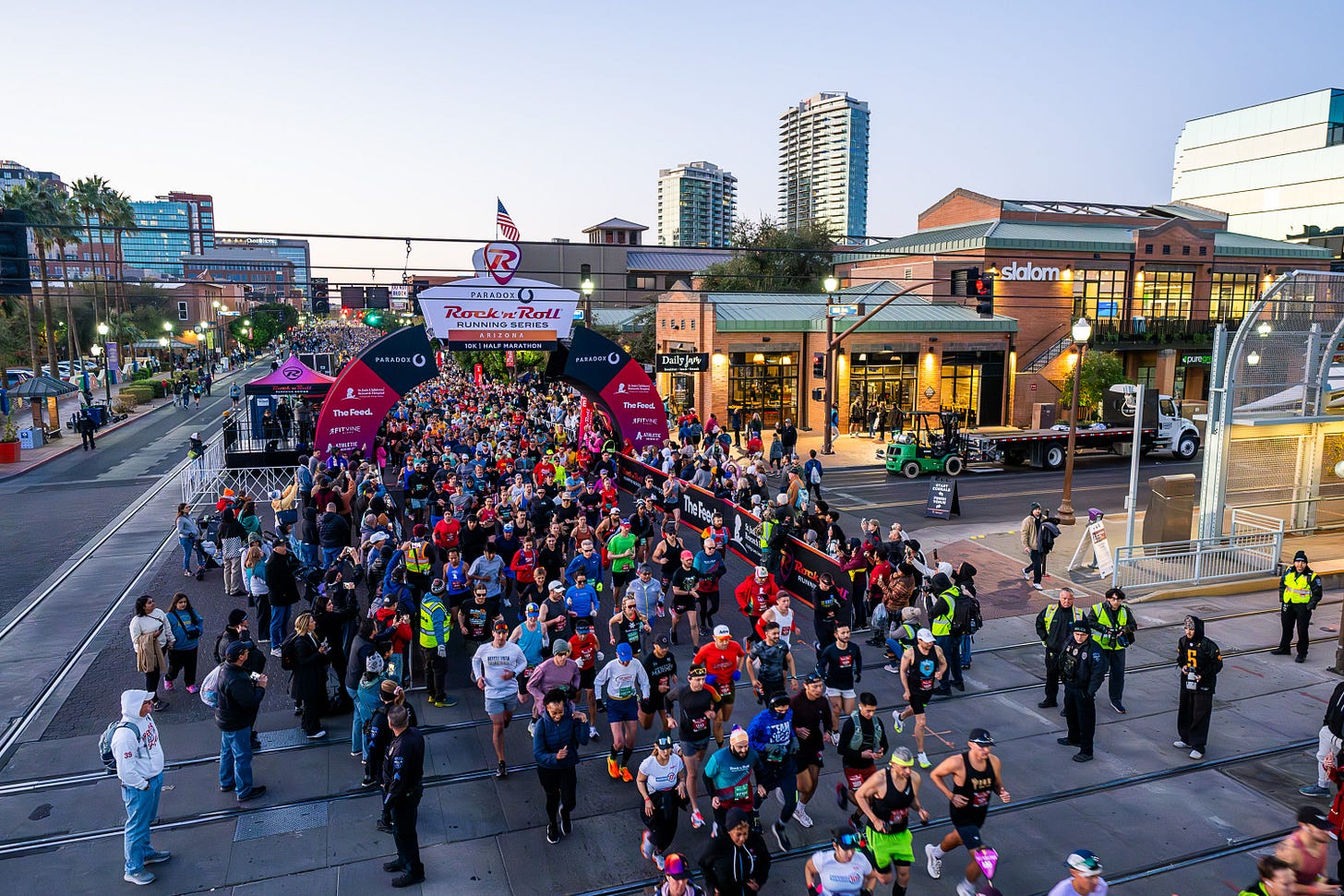
The elevation chart indicates a gentle uphill for the first few miles. In practice, I didn’t really feel it on the ground. In fact, the first nine miles or so of the course felt mostly flat and had no significant hills despite some gentle undulations. However, there’s one moderately serious climb on the inbound as you near mile 10 before you cruise gently downhill to the finish. Fortunately, this is at the start of the part when you’re up close to the desert landscape, so you have some scenic eye candy to distract you from the effort.
Crowd and course support seemed about average, except there was some quite rousing cheering in the last few hundred yards. The name of the Rock ’n’ Roll series reflects the live music along the course that’s its hallmark — but which, in practice, tends to be more evident at some events than others. There was some of it in this race. Course entertainment can provide some fleeting encouragement during a 13.1-mile run, but most people who like to run to music wear headphones (although my headphones failed to work that morning).
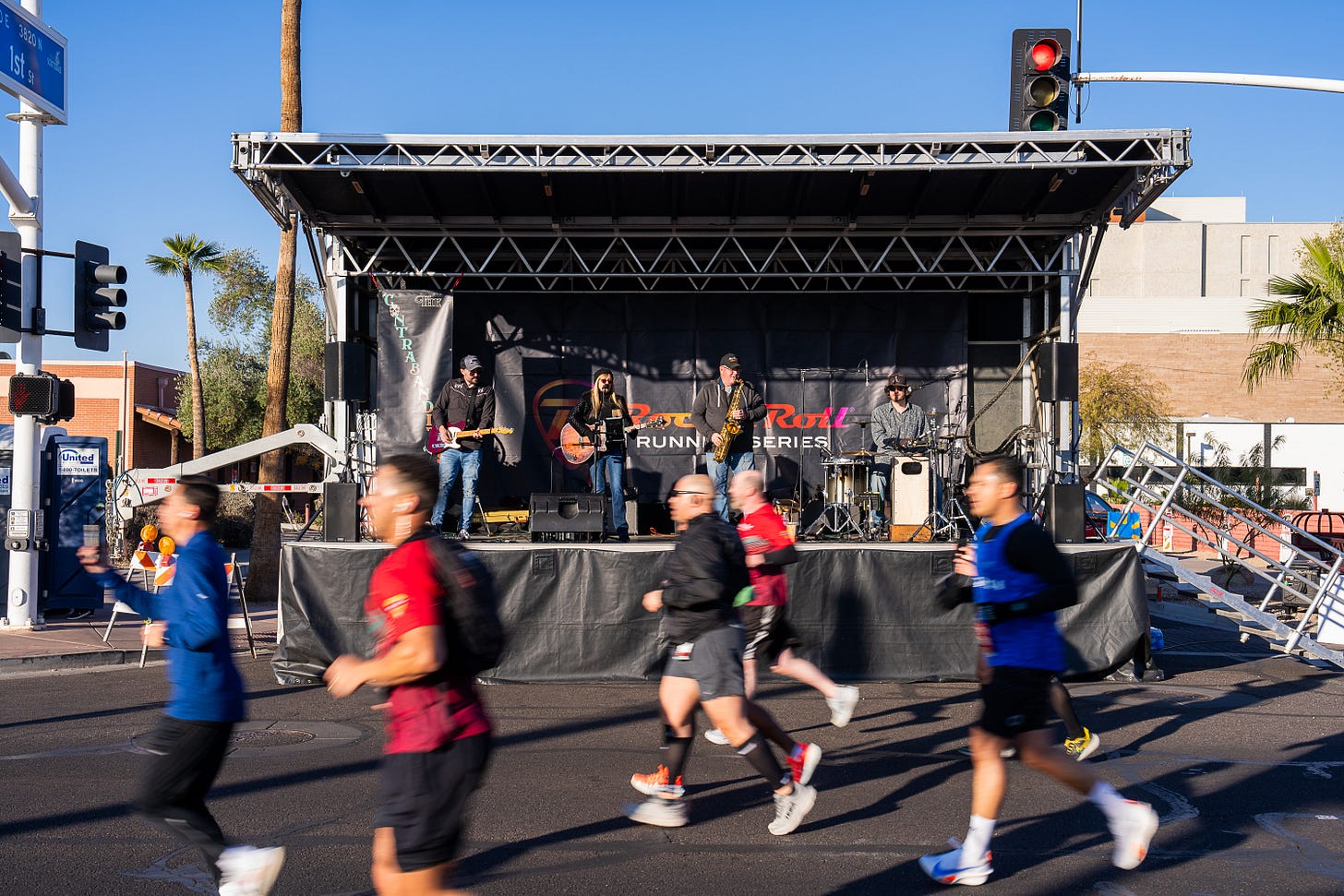
The finish festival was quite lively and better than most. It took place in Tempe Beach Park, where the race ends, and many runners appeared to linger for a while.
Overall, I enjoyed the race and recommend it. It had a good, upbeat vibe. I wouldn’t place it in the bucket-list category, but it should be on the shortlist of people looking for major North America half marathons close to the start of the year. (Although that, as noted earlier, is, indeed, quite a short list.)

My own goals for this first race after my hiatus were modest — mostly just to run the entire thing, including the hill. I managed that, and finished in 2 hours 24 minutes — that’s about 20 minutes slower than where I was a couple of years ago, but I was glad just to be back in a race. I was pleasantly surprised to discover that this less-than-stellar time placed me in the top half of my division (just).
Athletic: my favorite non-alcoholic beer, by far
Runners’ bibs included a tear-off voucher for a free beer at the finish festival, but the line was pretty long. I didn’t join it but instead headed over to another tent — with hardly any line — for some free non-alcoholic beer.
I wouldn’t necessarily have bothered but for the fact that the brew was Athletic — by far the best non-alcoholic beer I have ever come across. As much as I enjoy “real” beer (at least certain types), I find Athletic tastes at least as good and often better. It comes in several versions, but my favorite is Run Wild, an IPA. Highly recommended. (Athletic isn’t a zero-alcohol beer. Like many beers that count as “non-alcoholic,” it contains less than half a percent alcohol, so up to 10% of what you’d find in a mainstream regular beer.)
Lodging and transportation
I used Valley Metro — Phoenix’s light rail — to get around. You can get from the airport to the expo at the Convention Center that way — the first leg is on a free airport train that connects with the city’s transit system — and then ride over to Tempe where there’s a stop in the vicinity of a number of hotels convenient for the race. There are ticket machines on the platforms if you don’t want to mess with the app. Unless you need a car for other reasons, there’s really no need to rent one if you’re traveling to Phoenix for this race. Downtown Tempe is very walkable.
I stayed at the Vib hotel. Vib is a Best Western foray into the hip, three-star boutique market. The hotel was fine — it has a cool roof terrace — and was only about a five-minute walk from the area where runners line up for the race. I paid $208 including taxes and fees, which is probably at the better end of the going rate around there for race weekend. But there are a number of other hotels in the area that could also be good picks. The key thing, in my view, is to be close to where the race starts and finishes.
There weren’t many choices in the vicinity for an eve-of-race pasta dinner, but I did find one close to my hotel. This was Caffe Boa, a lively spot where I had a decent spaghetti with meatballs washed down with some Croatian wine — the latter not what I’d necessarily expect in downtown Tempe.
Phoenix airport lounge notes
Phoenix airport has a number of lounges. American is the largest airline at the airport and has three Admirals Clubs. I didn’t get to any of them on this trip, but I’ve visited them before and none are anything special in terms of the hard product (as opposed to the always friendly staff). American has done great things with even relatively small lounges — such as its one at Denver — and the Phoenix ones seem due for a refresh.
The loads on the morning nonstop American flight from my home town — Santa Barbara — to Phoenix weren’t looking good for standby. So I ended up flying on United via Los Angeles. That meant I got to check out the United Club on arrival at Phoenix.
I wouldn’t necessarily even assume United would have a lounge at Phoenix. It isn’t one of their hubs (or even a “focus city,” as far as I’m aware). But it has a decent lounge, which opened in 2022 and is at least as good as American’s. The food seemed better than what I’ve had at the Phoenix Admirals Club locations in the past.
I flew home on American but instead of going to the Admirals Club, I thought I’d check out the new Chase Sapphire Lounge. This was the first time I’d been to a credit card lounge in the United States. By “credit card lounge,” I mean one that is operated/branded by a credit card — and only available to cardholders — as opposed to an airline-operated/branded lounge to which you might have access via an airline-affiliated credit card.
The experience was different, but overall good. When I arrived, I was told there was a wait. There has been a lot of talk recently about airport lounge crowding, but — personally — I’ve rarely encountered waits to get into airline-operated lounges (although have often found crowded conditions once inside). The door staff at the Chase Sapphire Lounge are reluctant to estimate wait times, but I was able to glean that it probably wouldn’t be more than 20 minutes. I had time, so I took the offered buzzer/pager and found some seating nearby. The buzzer went off in under 15 minutes.
What was different from an airline lounge is that when I was admitted, the hostess guided me to where I was meant to sit — sort of like when you arrive in a restaurant. (At least, a restaurant in the United States — in other parts of the world, there is often a seat-yourself culture.) I was shown to a corner seat at the bar, close to windows and with reasonable elbow room — so not a bad spot.
Maybe they don’t assign seating when the lounge is less full. I’d been to the Chase Sapphire Lounge in Hong Kong the previous year and they didn’t do it there. I’m not saying assigned seating is good or bad. But it somehow makes for a different, more curated experience.
The food and bev at the Chase Sapphire Lounge were definitely a cut or two above what you’d find in the Admirals Club or United Lounge. There were two food stations — one with a chef — serving a variety of tasty small plates. Some people were drinking elaborate cocktails. I had some pretty decent French white Burgundy — somewhat nicer than the house wines in the regular airline lounges (acceptable as the latter are).
I believe the Chase Sapphire Lounge at Phoenix is actually operated by the company that owns Priority Pass and also operates lounges in various U.S, airports under the “The Club” name. PP cardholders can also access it, although they have less priority on the waiting list than those with Chase Sapphire cards.
Credit card lounges versus airline ones
Overall, the Chase Sapphire hard product is objectively better than most regular U.S. airline lounges (as opposed to, perhaps, a premium lounge for long-haul business class passengers such as a United Polaris or American Flagship lounge). However, at the same time, part of me prefers the regular airline variety. Being in the Chase Sapphire lounge is a bit like having an urban experience of some sort, which happens to be in an airport. But as an aviation geek, I slightly missed the sense of being under the wings — so to speak — of the airline I was about to board. Airline lounges in subtle ways feel more part of the aviation experience than random lounges that happen to be in airports. Of course, those less enamored of aviation might consider airline-independence an advantage.
A clear benefit of airline-independence is that you can use credit card lounges regardless of which airline you’re flying on. That used also to be the case with airline ones. If you belonged to the Admirals Club, for example, you could use the lounge even if you were flying on United or Delta. But that changed about 15 years ago. The old system lasted surprisingly long, but it already seems like another era in the history of lounges.
Lastly, let’s talk about lounge restrooms
Both the Chase Sapphire and United lounges at Phoenix are relatively new and both are taking a newish approach to the provision of restrooms. Instead of conventional male and female restrooms — with male ones comprising both urinals and stalls — there are unisex (or “all gender”) restrooms that comprise private rooms with a toilet, basin, etc. The direct entrance into these are in public hallways — you don’t first go into some type of vestibule with basins, etc., and only then step into your private room. But the problem is that in both the United and Chase Sapphire lounges, there were only two of them.
The United Club at Phoenix has seating for 122 and the Chase Sapphire lounge can apparently seat 60. Maybe two restrooms is enough for 60 people — barely — but it seems rather few for over 100. This is especially so as many travelers make a point of using lounge restrooms, which can — if you don’t have to wait — provide one of the better options over the course of a journey.
While I was in both Phoenix lounges, people seemed to be waiting to use a restroom almost all the time. And with only two, it makes it more awkward for someone who might, for whatever reason, be taking a little longer than usual. There’s less anonymity than with a long row of stalls, and more likelihood of impatient looks when a lingerer leaves.
Shortages of toilets are not unique to lounges adopting the unisex model. I find many lounges with separate gender bathrooms also provide too few. I realize space is limited when designing lounges. But I often see wasted or unused space, such as work cubicles that hardly anyone uses or alcoves for ancient fax machines. Restrooms might not be the most glamorous part of a lounge. They are nonetheless among the most important, and so should be afforded the space they need.
A good travel hack, where possible, is to skip the regular restrooms and go to a shower room. Showers are not a feature of most lounges — and there were none in Phoenix — but they are not uncommon. And typically, you get a full private bathroom, including not just the shower and basin but also a toilet (and a surface on which to rest your luggage). Sort of like a hotel bathroom. And there’s generally no expectation that you will be especially quick. Plus, the shower rooms are cleaned between uses. So even if you aren’t in need of a shower, using the room can make for a more civilized experience than competing for a spot in a regular restroom.
And, if you have time, you could always actually take a shower while you’re at it. Having a lounge shower isn’t quite the same as having one on an airplane (think First Class on an Emirates A380), but it’s maybe the nearest thing for aviation geeks wanting to stay clean.
Phoenix race sum-up
For: Medium-size race at a time of year when North America pickings are few; decent course; efficient organization. Against: Inconvenient expo; a sense of a race that has been in decline (although only noticeable if you’ve done it before). Sum-up: Worth a trip from within North America if you’re looking for a winter race. ✈️ 🏃
If you’ve stumbled across this post, please consider subscribing to this blog using the button below. It covers the intersection of running, travel, and aviation, and includes race reviews from around the world. Subscribing costs nothing — and never will — but supports the site. You’ll get an email every month or two with new posts.
For a list of other recent posts, click here.
And please share this post with others who may be interested, using this button:



